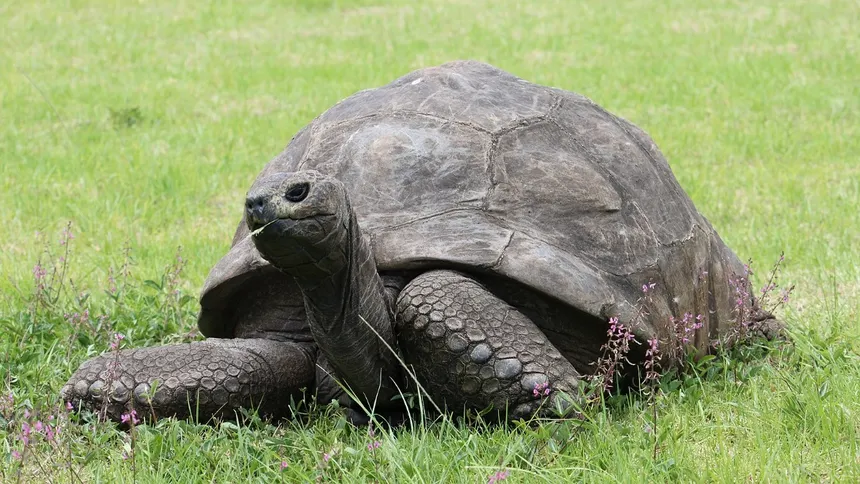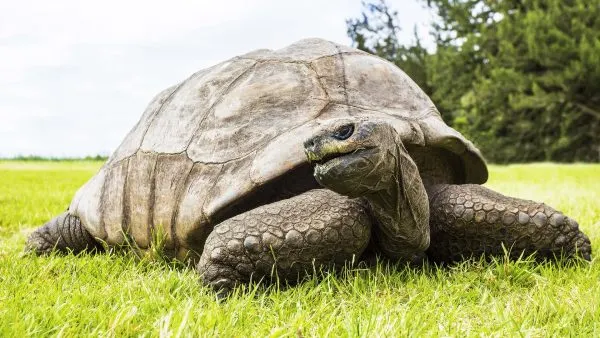“Jonathan the Tortoise: The Oldest Living Land Animal on Earth”

Jonathan is not just a tortoise—he is a living legend. Born in the early 19th century, Jonathan holds the extraordinary title of the oldest known living land animal on Earth. His longevity offers a fascinating glimpse into natural history, biology, and the enduring charm of tortoises. This long brief article provides a comprehensive look at Jonathan’s life, species, care, historical milestones, and his symbolic importance in both science and culture.
Who Is Jonathan the Tortoise?
- Species: Seychelles giant tortoise (Aldabrachelys gigantea hololissa)
- Estimated Hatch Year: circa 1832
- Current Age (as of 2025): Approximately 193 years old
- Location: St. Helena Island (a remote British Overseas Territory in the South Atlantic Ocean)
- Status: Recognized by the Guinness World Records as the oldest known living land animal
- Home: Plantation House, the residence of the Governor of St. Helena
Historical Context
Jonathan was believed to be about 50 years old when he arrived on St. Helena in 1882 as a diplomatic gift from the Seychelles. That means he predates major world events such as:
- The invention of the lightbulb
- The reign of Queen Victoria
- The invention of the telephone
- Two World Wars
- The moon landing
- The internet era
He has lived through 39 U.S. presidents, 8 British monarchs, and numerous revolutions in science and society.
Species Background: Seychelles Giant Tortoise
- Once believed extinct in the wild, the hololissa subspecies is part of the Aldabra group of giant tortoises.
- Native to the Seychelles, but many individuals were transported during the colonial era.
- They can grow up to 4 feet (1.2 meters) long and weigh over 400 pounds (180 kg).
- Lifespan usually ranges from 100 to 150 years, though some—like Jonathan—exceed this.
Physical Condition and Care
Despite his age, Jonathan has had a remarkably healthy life. In recent years, however, age-related challenges have emerged:
- Blindness: Jonathan is blind due to cataracts.
- Loss of Smell: He has a diminished sense of smell.
- Appetite: Still robust, especially for treats like bananas, cucumbers, apples, and carrots.
His caretakers provide a specially curated diet, hand-feed him when needed, and ensure he lives a stress-free, monitored life.
Jonathan is cared for by the St. Helena Government Veterinary Team, and his health is regularly assessed. A younger female tortoise named Emma is among his companions.

Personality and Behavior
- Jonathan is known for being gentle, calm, and sociable, especially with familiar humans.
- He spends much of his time sunbathing, resting under trees, or exploring the grounds.
- Although breeding attempts were made, Jonathan never produced offspring, and it’s suspected he may be asexual or sterile—or possibly even homosexual, given his long-term companionship with another male tortoise.
Symbolism and Recognition
- National Icon: Jonathan is the most famous resident of St. Helena, even featured on the island’s five pence coin.
- Tourist Attraction: He is one of the top reasons people visit St. Helena.
- Cultural Symbol: Represents resilience, patience, and natural history.
- Conservation Emblem: His survival underscores the importance of conservation for long-living, slow-reproducing species.
Scientific and Educational Significance
Jonathan’s longevity is of great interest to biologists, veterinarians, and zoologists. His continued health offers insight into:
- Aging in reptiles
- DNA stability over centuries
- Effects of environment and diet on lifespan
- Animal care ethics and protocols for aging wildlife
Veterinarians emphasize that his environmental stability, proper diet, lack of predators, and consistent veterinary care are key factors in his extended life.
Fun Facts About Jonathan
- He was alive before the first photograph of a person was ever taken (1838).
- Jonathan was born before Charles Darwin published “On the Origin of Species” (1859).
- He’s older than many modern nations.
- He is considered the oldest tortoise ever recorded with verifiable documentation.
- His name, “Jonathan,” was given to him decades after his arrival on St. Helena.
Legacy and Preservation
As of now, Jonathan is expected to live out his remaining years in peace and honor.
His caretakers have ensured that:
- His legacy is preserved through documentaries, articles, and educational resources.
- Conservation lessons are shared using Jonathan as a charismatic ambassador.
- DNA samples and data are maintained to assist future studies in longevity.

Conclusion
Jonathan the tortoise is a testament to the miracles of nature and the care of compassionate humans. From colonial times to the digital age, his life spans nearly two centuries of human and natural history. More than just a biological marvel, Jonathan serves as a living bridge between eras—and a symbol of hope for the longevity of the planet’s most ancient creatures.



